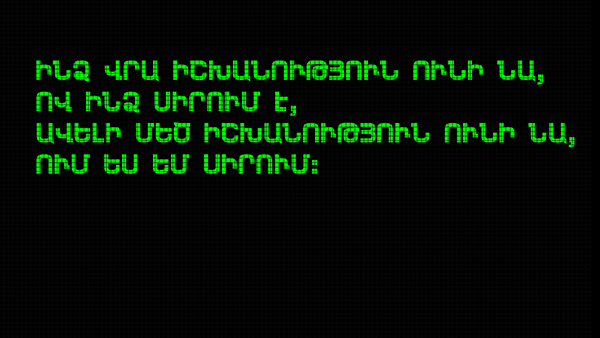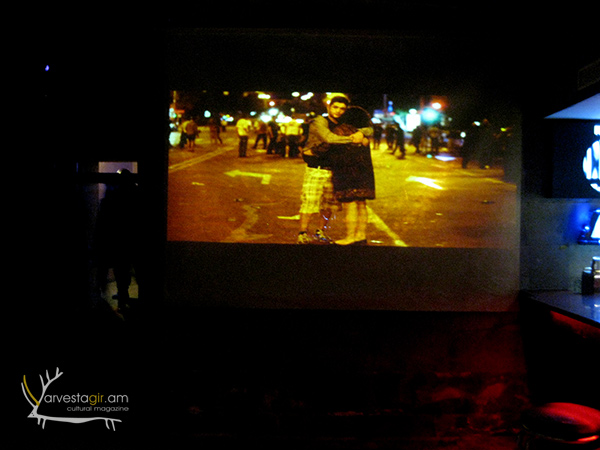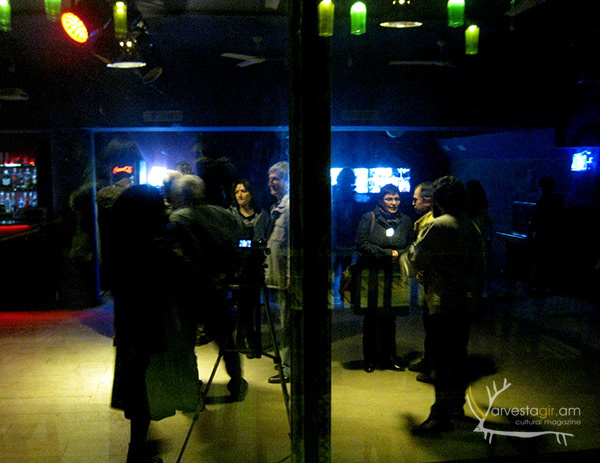 ArtBasis is pleased to present Grigor Khachatryan’s exhibition “Im-potences: Power against Love” curated by Nazareth Karoyan in Club 11, 17 Baghramyan Ave., Union of Architects. The exhibition will be on view from February 29 through March 30, 2016.
ArtBasis is pleased to present Grigor Khachatryan’s exhibition “Im-potences: Power against Love” curated by Nazareth Karoyan in Club 11, 17 Baghramyan Ave., Union of Architects. The exhibition will be on view from February 29 through March 30, 2016.
The subject of Grigor Khachatryan’s project is the social revolt against the electricity price hike that took place last summer. Incorporating the photo and video footage of the events, the gestures adopted by the protesters, as well as the written and oral speech acts, he explores the problem of the relationship between the sit-in participants who blocked Baghramyan Avenue for several weeks and the police. The interrelated theme of power and love in general is central in Grigor Khachatryan’s oeuvre. Working in performance and turning his own persona into material the artist constructs a parodic figure vested with absolute power. In this project Grigor Khachatryan does two things for the first time and simultaneously. Firstly, he departs from the performance format that was dominant in his artistic practice and builds his project on research. Secondly, he takes off the jester’s happy clothes to put on the rigorous robe of the one who looks into the sources of the power’s legitimacy.
The fragile barricade built with garbage bins has blocked the Baghramyan Street. On the one side there are the police of the authorities lacking legitimacy who can use force within the scope of its functions prescribed by law, on the other side there are the angry citizens that do not have any other option than to violate the social norms. To insist on their righteous demand they turn to the various means they have in their armory – from demonstrative love to the gestures and slogans with hints and messages of sexual nature. For the artist the problematic is that division. With his project he as if raises a question: can love, as speech and action, become a form of public resistance and struggle against the police violence? He derives the possible answer to this hypothetical question from the scenes of the dispersion of the sit-in accompanied by love hits of the ‘60s and ‘70s. Shrouding the icy water jet fired from the water cannon with the repetitive rhythms of wistful songs Grigor Khachatryan as if comes to push the viewer deep into sad reflections: how powerless the authorities must be to oppose the citizen who elects them with such rude and harsh methods, or how hopeless that ordinary protester must be to rely on the potency of the gesture conveying the threat of sexual violence – the raised middle finger.
The saying of the artist which is included in the installation points that binary opposition and the way to overcome the crisis:
THOSE WHO LOVE ME HAVE POWER OVER ME, GREATER POWER HAVE THOSE WHOM I LOVE.
Public program of the exhibition…
The public program of the project “(Im)potences: Power against Love” has a double aim. On the one hand it proposes to analyse the material that lies on the basis of the project, on the other hand to discuss the problems that emerge from the content layers of the project.
 Media traps or the demonstrativeness: voluntary-compulsory…
Media traps or the demonstrativeness: voluntary-compulsory…
If the civil society activists had multiple reasons to carry the struggle in the legal direction, the selection of its methods, particularly the aestheticization, was mainly due to the resources at hand. The technical means of the production of writing and its distribution have created new possibilities and methods for the organization of civil struggle. Is the preference given to the visual and discursive forms a tactical display of those methods? They are also means to oppose that struggle – constrain and neutralize it with media manipulations, fake initiatives and positioning. How was the media disposed on this and the other side of the barricade along Baghramyan avenue.
Multitudes / collective artwork…
The participants of the Baghramyan sit-in while assessing what had happened and showing their attitude towards this or that speech, posture or deed turned to the help of generalizing forms of the message. Various metonymies, metaphors were created, changes in the word meanings were made, which had at their base visual, verbal or phonetic analogies. With their syncretic nature they came to turn the participants into authors of a collective artwork. Are the social-political or various other movements mandatory conditions for that kind of folkloric production? How public movements and creative processes are connected together? Are those connections causative or nevertheless we can consider those movements also a collective creative process in itself.
 Foul language, demonstration of threat of violence or political correctness: around the relevance of the participation forms of civil protest…
Foul language, demonstration of threat of violence or political correctness: around the relevance of the participation forms of civil protest…
During the days of civil protests the most loudly pronounced criticism was based on the tantamount analysis of visual and verbal means of protesters’ organized resistance. The text is not merely criticism, but also a call-appeal to the demonstrators. The questions that arise about that mode of participation come from the double nature of the text. Can any public movement be self-sufficient without inner criticism and simultaneously how pragmatic is criticism, how appropriate is it to target the one on the barricade. And finally can the two forms of the discourse (criticism and appeal) be combined in terms of reaching each of the dual purposes of the text.
The politicization of art against the aetheticization of politics…
French philosopher Jacques Rancière says that aesthetics is in trouble today – being identified with politics, moreover not by accident but in essence. But isn’t politics in the same trouble? Isn’t politics in its turn aestheticized? In global terms it has ceased to produce subjectivities being fully surrendered to the aesthetic passion of the management to render flawless and perfect. Those who love me have power over me, greater power have those whom I love – says Grigor Khachatryan speaking in general on behalf of art. Can art become a communicative means ensuring the cultural-political unity of the public?






Leave a Reply